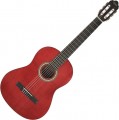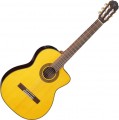Pickup
The presence of
a pickup in the design of the guitar.
The pickup allows you to connect the instrument to external equipment — for example, for a concert; it, in accordance with the name, provides sound transmission from the strings to the output (usually through the tone block, see below). By definition, all
electric acoustic guitars have this feature, and basses are usually equipped with pickups (see “Type”).
Type
The type of tone block installed in a guitar with a pickup (see above).
The tone block is responsible for processing the signal coming from the pickup before applying this signal to the output of the instrument. Such processing includes at least frequency correction, often also amplification; in addition, it is through the tone block that such functions as a tuner for tuning and an equalizer are implemented (see below). And the types of such blocks can be as follows:
— Active. Tone blocks operating from their own power source (usually a replaceable battery). Such modules are more complicated and more expensive than passive ones, besides, when using them, you need to monitor the condition of the batteries and change them in time. On the other hand, the active operation scheme allows you to implement many advanced functions: high-quality frequency correction, gain, impedance matching with an external amplifier, as well as the equalizer and tuner mentioned above. Thus, most guitars with pickups nowadays are equipped with active tone blocks.
— Passive. Passive tone blocks do not have electronics that require additional power, so they are inexpensive and extremely easy to use. At the same time, the capabilities of such blocks are much more modest: for example, timbre correction in them is carried out only by cutting off “extra” frequencies, and there is no talk of amplification at all. This variant has not been widely used.
Equalizer
The presence in the guitar tone block (see above) of the
equalizer function.
The equalizer in this case means the ability to set the volume level for each individual frequency band. This allows you to quite accurately adjust the tone block to the desired sound. Guitar equalizers usually have less than 3 bands (low, medium, high frequencies) — this is quite enough for the initial adjustment (it makes sense to fine-tune the sound already on external equipment).
Tuner
The presence of a built-in
tuner in the guitar tone block (see above).
The tuner is used when tuning the guitar: it “listens” to each string and tells the musician how much the pitch of its sound corresponds to the reference (higher, lower, normal). This equipment greatly simplifies the setup. Tuners can also be produced as external devices, however, the presence of such electronics directly in the tone block is much more convenient: at least, it is always at hand and is not lost. For more details about the features of such devices, see "Tuner" below.
Cutaway
Special
cutout on the body of the guitar. It is located at the base of the neck, to the right of it, if you look at the upright guitar from the front (in left-handed models — on the left). This feature makes it much easier to play on the upper frets (located near the rosette): without a cutout, the body would prevent reaching them. Therefore, this feature is highly desirable for guitarists who play notes at high frets (from the 12th and above).
There is an opinion that the cutout negatively affects the acoustics of the guitar (reduces the useful volume of the body, reduces the volume and saturation). However, in most cases, this effect is almost imperceptible, especially since manufacturers often use various tricks to compensate for this effect.
Body
Guitar body construction, including both soundboards and sides. For these parts, two main types of wood can be used: solid (solid) and puff (better known as plywood). Plywood is cheaper than solid wood, but loses to it in terms of acoustic properties. Therefore, the type of deck in the characteristics is usually indicated only if solid wood is present in it. However, if data on the deck is not given, this does not mean that the instrument is made entirely of plywood; in addition, it is worth noting that some types of plywood come close to solid wood in terms of acoustic properties. Therefore, without having information on the deck design, it makes sense to focus primarily on the price category of the instrument.
Options for a solid tree can be as follows:
—
One piece top. The English name is also used — solid top. We are talking about instruments in which only the upper deck is made of solid wood — the rest of the body is made of plywood. This option is a good compromise between sound quality and affordable price, it is quite popular in mid-range guitars.
—
Completely whole. A body in which all parts are made of solid wood — both decks and sides. This is the most advanced option in terms of acoustics — especially since some types of wood even improve over time (provided that it is solid wood). However, a completely one-piece body is quite expensive, so this option is found
...mainly in high-end professional instruments.Bottom deck
The material from which the lower soundboard of the guitar is made is a flat surface on the opposite side from the upper soundboard (it is this surface that is adjacent to the musician's body when the instrument is held normally).
The value of this parameter is described in detail in the “Upper deck” section — what is stated there is also true in this case. We only note that a wider range of materials is used for the lower deck: this part is less demanding on the characteristics of the material, which gives manufacturers additional choice.
In terms of specific materials,
rosewood,
sapele,
maple,
meranti and
nato, among others, enjoy considerable popularity in modern times. Here is a brief description of each of them:
— Rosewood. A name that combines the wood of several species of tropical trees. This material is said to provide deep sound and enhance bass quality, thereby improving the guitar's efficiency when playing rhythm parts on chords.
— Sapele. Also known as "African mahogany" due to its characteristic hue. It contributes to an even sound with medium depth and good expression of individual notes, which is considered important especially in solo parts.
— Maple. Maple wood is prone to a rather sharp and sonorous sound without much depth. However, this is
...not a drawback, but a feature: for some styles of music, just such a coloring of the sound is perfect.
— Meranti. Wood of trees of the genus Shorey, growing in the tropical forests of Southeast Asia. This material is mainly used in instruments manufactured by Yamaha, mainly classical guitars and ukuleles — it is for these varieties that meranti is considered the best option.
— Nato. A relatively inexpensive variety of mahogany (mahogany) used in guitars in the corresponding price range. Contributes to a dense, but not very bright sound.Shell
The material from which the side of the guitar is made is the “side” surface of the body, which unites the upper and lower soundboards (see above).
About the meaning of the material of the body, see paragraph "Top deck" — everything stated in it is also true for the shell. Unless the range of materials used for this part is noticeably wider; also note that most often the material of the shell coincides with the material of the bottom deck. Here is a summary of some of the more popular options:
— Rosewood. A name that combines the wood of several species of tropical trees. This material is said to provide deep sound and enhance bass quality, thereby improving the guitar's efficiency when playing rhythm parts on chords.
— Sapele. Also known as "African mahogany" due to its characteristic hue. It contributes to an even sound with medium depth and good expression of individual notes, which is considered important especially in solo parts.
— Maple. Maple wood is prone to a rather sharp and sonorous sound without much depth. However, this is not a drawback, but a feature: for some styles of music, just such a coloring of the sound is perfect.
— Meranti. Wood of trees of the genus Shorey, growing in the tropical forests of Southeast Asia. This material is mainly used in instruments manufactured by Yamaha, mainly classical guitars and ukuleles — it is for these varieties that meranti is considered the best option.
— Nato.... A relatively inexpensive variety of mahogany (mahogany) used in guitars in the corresponding price range. Contributes to a dense, but not very bright sound.
Bridge
The material from which the bridge (string holder) of the guitar is made is a device with which the strings are attached to the top deck.
Theoretically, the colour of the sound of an instrument depends on the characteristics of all its details. However, in the case of the bridge, this influence is so insignificant that the data on the material in this case are more of general reference and advertising than of real practical value. The variety of such materials is quite large; among the most common are
rosewood,
mongoy and
ebony.

